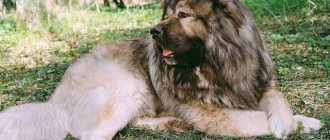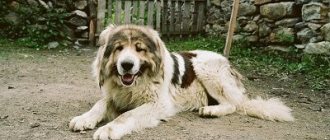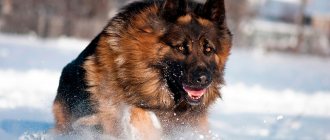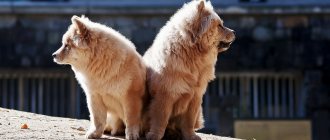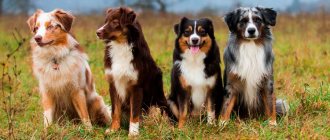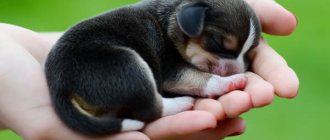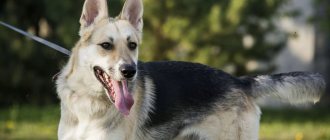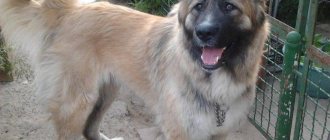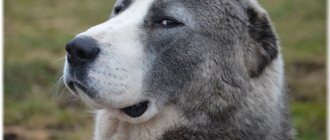The South Russian Shepherd Dog (YURO) is an undeservedly forgotten domestic breed, which is used for guard and shepherd service. The best representatives of the breed fascinate with their harmony, beauty and balanced behavior, while they retain their degenerate working qualities and are distinguished by their unpretentiousness and malice. They require special coat care.
Breed standard and description
Height at withers: males from 66 cm, females from 62; Weight: males from 35 kg, females from 30 kg.
- Color: white, gray, fawn, spots with blurred outlines are acceptable, also a white mark on the muzzle, spots everywhere except the body and base of the tail in gray and fawn tones.
- Eye color: brown.
- Nose: black, it is acceptable to lighten the central part of the nose in winter in fawn dogs.
- General appearance: a dog with high and strong legs, heavy hair on the face and limbs, the coat is hard, but does not fit tightly to the body.
Disqualifying signs:
- Misbehavior;
- Rounded skull shape;
- Missing teeth, with the exception of P1 and M3;
- Bite different from scissor bite;
- Docked or short tail from birth;
- Cowardice, excessive excitability, aggressiveness;
- Males in the bitch type (small, with thin bones);
- Any eye color except brown;
- Wool with curls or in cords;
- Any artificial changes in appearance;
- Short hair;
- Absence or lack of pigmentation of the eyelids, lips, nose;
- Square body format;
- Amble;
- Sideways movements;
- Cryptorchidism.
Also, much attention is paid to height; a deviation from the standard of 2-3 cm is considered a disadvantage, and a deviation of 3 or more is considered a defect.
a brief description of
Outwardly, the South Russian Shepherd Dog is very similar to a huge lapdog, however, it is not so affectionate and peaceful. This is a serious, working dog, which is intended for guard duty and territory protection. Dogs are quite aggressive and vicious towards intruders.
The main difference and pride of this dog is its thick snow-white fur, the length of which sometimes reaches more than 10 cm. The height of a shepherd dog can be 68 cm, bitches are slightly lower, and its weight is 56 kg. The head is small, slightly elongated. The ears are small and hidden in thick fur. The body is large and muscular. The paws are voluminous and completely covered with hair. Visually reminiscent of winter boots. Due to the dense, abundant vegetation, almost no features are visible; the animal is one continuous ball of wool.
The coat is quite soft in winter; it becomes coarser in summer, thus allowing the animal to control body temperature.
Naturally short hair indicates that the animal is not purebred.
History of the breed
The homeland of the breed is the Crimean and Kherson steppes . There is no consensus on the true origin, but many hypotheses. One of the main versions was suggested by the famous dog handler of the Soviet era, Mazower. He believed that the South Russian Shepherd Dog descended from Spanish herding dogs and several local breeds. Among them is the so-called Krymka - a greyhound with outstanding hunting abilities. Today this breed is completely lost.
Mazower described how Spanish cattle dogs came to Eastern Europe. Enterprising businessmen took out a loan from royal officials and agreed that they would bring Merino sheep from their country. Dogs also arrived on board the ships with them.
According to the surviving description, these Spanish shepherds were small, but did an excellent job with the flock. The predecessors could not resist predators, so a larger and more vicious dog appeared.
Another version says that their ancestors were ancient shepherds who came from Asia to the European steppes during the Great Migration. The dogs followed the people, and their appearance gradually changed. The main difference between such individuals is their bravado. Hair growth on the face and paws is also present in South Russian Shepherd Dogs.
Dogs of the breed have become indispensable assistants for shepherds . Unlike the same Central Asian and Caucasian shepherd dogs, Yuzhaks not only protected the herd from predators. They could also control the movement of sheep, as do collies, Pembroke Welsh Corgis and Shelties.
South Russian Shepherd Dogs calmly tolerated heat and any weather conditions due to their light build and dense coat. They were ruled by shepherds, other people were seen as a threat to the owner and the herd.
Most of the time, the southerners worked independently in the endless steppes, making decisions without the commands of the shepherd.
In addition to accompanying sheep, they were left in villages to guard houses and plots . Representatives of the breed have lightning-fast reactions and never attack for no apparent reason.
After the organization of collective farming, the Yuzhaks did not disappear, but began to work on an equal basis with people. They were placed to guard pastures, farms and warehouses. Of course, they continued to perform herding duties as before. Soviet specialists in nurseries were engaged in breeding pedigree individuals.
Even before the outbreak of World War II, the breed was recognized by cynologists of the USSR and was present at zootechnical events. They were called both Ukrainian and Russian Shepherds, but in the modern standard they remained South Russian.
Today, South Russian Shepherds are not common, but there are working representatives of the breed. They guard farms and industrial facilities, herd livestock and win championship awards at international exhibitions.
Health
This breed has fairly good health. The period of formation of the immune system and psyche takes approximately two years.
However, like all large breeds, they are prone to some serious diseases :
- Osteoarthritis.
- Osteoporosis.
- Dysplasia.
In addition, you may encounter :
- Epileptic seizures.
- Incomplete set of teeth.
- Intussusception.
- Allergic reactions.
- Eye problems.
- Cryptorchidism.
- Turning of the eyelids.
It is worth noting that with proper care and maintenance, these dogs can live quite a long time without any problems. The average lifespan of a dog can be 12 years.
Temperament and character
Positive traits of South Russian Shepherds:
- Devotion;
- Confidence in your strength;
- Independence;
- Endurance;
- Ability to stand up for yourself;
- Equilibrium;
- Fast reaction;
- Silence.
Negative features:
- Prone to escape;
- It is difficult to understand their reaction from external signs;
- Wayward.
Additionally, southerners are very wary of strangers and can attack in response to stroking without the owner’s approval.
Who is the dog suitable for?
South Russian Shepherds are suitable for experienced people because of their independence and determination. These qualities force the owners to develop a reaction and painstakingly build relationships with the pet. Yuzhakov is distinguished by freedom of thinking, which periodically leads to escapes and other unwanted things.
Otherwise, you can rely on these dogs without fear. They jealously protect their owner from attacks. They can work in harsh conditions, evidence of this is the large population in the northern regions. There dogs herd sheep, cows and horses.
If the family has no experience raising a serious dog, but has small children , then the advantages and disadvantages of purchasing a South Russian Shepherd dog must be carefully weighed.
If you have doubts and lack of confidence in your own abilities, it is better to wait until the child becomes a teenager and can take part in raising a formidable guard.
Yuzhaks do not touch animals, provided that they have the same owner. In other cases, the fate of a neighbor's cat or a curious dog can become sad. These shepherds get along well in a pack if they join it as a puppy.
The best option for keeping a Yuzhaka is a private house with a large plot or a spacious enclosure. However, such shepherd dogs are also kept in an apartment if the owners are not bothered by the abundance of hair.
How to choose a puppy
It is better to choose a South Russian Shepherd puppy from a professional breeding kennel. This is a guarantee of acquiring a purebred individual, with a good pedigree and a stable psyche.
When choosing, you must be guided by the following points:
- The puppy must be active; sluggish movements are not typical for this breed;
- Manifestations of aggressive play are acceptable in children and should be completely excluded in adults;
- The conditions for keeping parents and offspring must meet the requirements for care - large rooms, open spaces.
South Russian Shepherd Dogs are a worthy choice for active, self-confident people with strong leadership qualities. The ability to establish unquestionable authority is one of the main conditions for a puppy to grow into a loyal, obedient friend and protector.
Maintenance and care
South Russian Shepherds are hardy . Their double-layer coat protects them from heat and frost. The undercoat falls into felt and does not allow the body to overheat or cool down or get wet. Additional protection is provided by the white color and length of the hair.
Most South Russian Shepherds live outside . Leashing is possible, provided there are constant walks outside the territory, as is an enclosure with flooring and a booth.
It is better to organize a checkpoint consisting of several chains and a spacious house so that the dog can hide from the heat or precipitation.
If the pet lives in an apartment or at home, then walking is necessary every day - morning and evening. On the street, the dog must move actively to maintain moral and physical health. When living on a site or on a leash, the dog is walked once a day or more often. Southerners don't need clothes.
Feeding
Approximate daily diet for South Russian Shepherds:
- Raw beef or offal – 600-800 g;
- Cottage cheese, kefir – 100-200 g;
- Porridge with water from rice, buckwheat – 200 g;
- Vegetables, fruits – 100-150 g;
- Chicken egg – 1-2 times a week;
- Sea fish – 3-4 times a month.
These products are the basis of the diet. The weight is adjusted based on the dog’s individual characteristics: weight, activity, age and health.
South Russian Shepherds are unpretentious in food, but fatty foods, sweets and cow's milk are not good for them.
Dry food is chosen for medium breeds and categories not lower than premium. Vitamins and mineral supplements are prescribed exclusively by a veterinarian. Due to its lightweight nature, joints are rarely injured in puppies and adult dogs.
Grooming
The fur of South Russian Shepherds has become the cause of many prejudices. For example, that you can’t comb them. This is a misconception; well-groomed fur looks beautiful and does not bother the dog . Tangles in large quantities cause inconvenience, the skin underneath them collapses and eczema and wounds occur. However, slight matting of the undercoat is acceptable. To do this, dogs are brushed several times a month, and during the shedding period 2-3 times a week. The bangs do not interfere with the dog and do not harm the eyesight; they are pinned for the owner’s pleasure and aesthetics.
Washing the Yuzhaks is easy. It is enough to dilute a suitable shampoo with water in a regular spray bottle and apply it to the animal’s wet fur. Another way is to moisten a sponge in diluted detergent and spread it over the entire surface. After this, lather a second time and rinse with water.
It is not necessary to use conditioner or balm; the fur of the Yuzhaks should resemble felt to the touch .
The current standard does not allow cutting , visible grooming or shaving of South Russian Shepherds. However, the hair in the ears and between the paws is carefully trimmed to maintain hygiene if it is far from exhibitions. The ears are cleaned with a special product. Their teeth are naturally strong, but they are periodically treated with ultrasound to remove stones or plaque. Excessively overgrown claws are slightly shortened with suitable forceps.
Video
* We invite you to watch a video about the South Russian Shepherd Dog . In fact, in front of you is a playlist in which you can select and watch any of 20 videos about a given dog breed by simply clicking on the button in the upper right corner of the window. In addition, the material contains quite a lot of photos. By looking at them you can find out what the South Russian Shepherd looks like.
In this article:
|
Rate the material!
[Total votes: 1 Average: 5]
Training the South Russian Shepherd
South Russian Shepherd Dogs are frequent guests at training grounds. Dogs are happy to follow commands and quickly remember them at the beginning of training. Sometimes they refuse to follow directions, but this can be easily corrected with encouragement and persistence.
Working trials are not available for this breed, but it is possible to test your dog at special shepherding events. Yuzhaks are trained for sports . In addition to the standard obedience course, such dogs are trained in guard duty and detention, showing good results. Suitable for work in departmental nurseries.
Reviews
- Marina, 41 years old, Moscow
I love my Mars very much, but there were serious difficulties in my upbringing. At 4 months, we contacted a specialist, which could save ourselves a lot of nerve cells. Now everything is fine, he listens perfectly. We eat only about the plan, we are allergic to everything else.
- Stanislav, 34 years old, Odessa
We thought there would be problems because of the fur, but with regular grooming there are no problems, you just have to cut the bangs and ears yourself. It is enough to scratch every day and I would also recommend a balm, it is a little expensive, but after it the fur is just a fairy tale, I bought it at the veterinarian.
Share link:
Breed photo
A selection of photos of the South Russian Shepherd.
